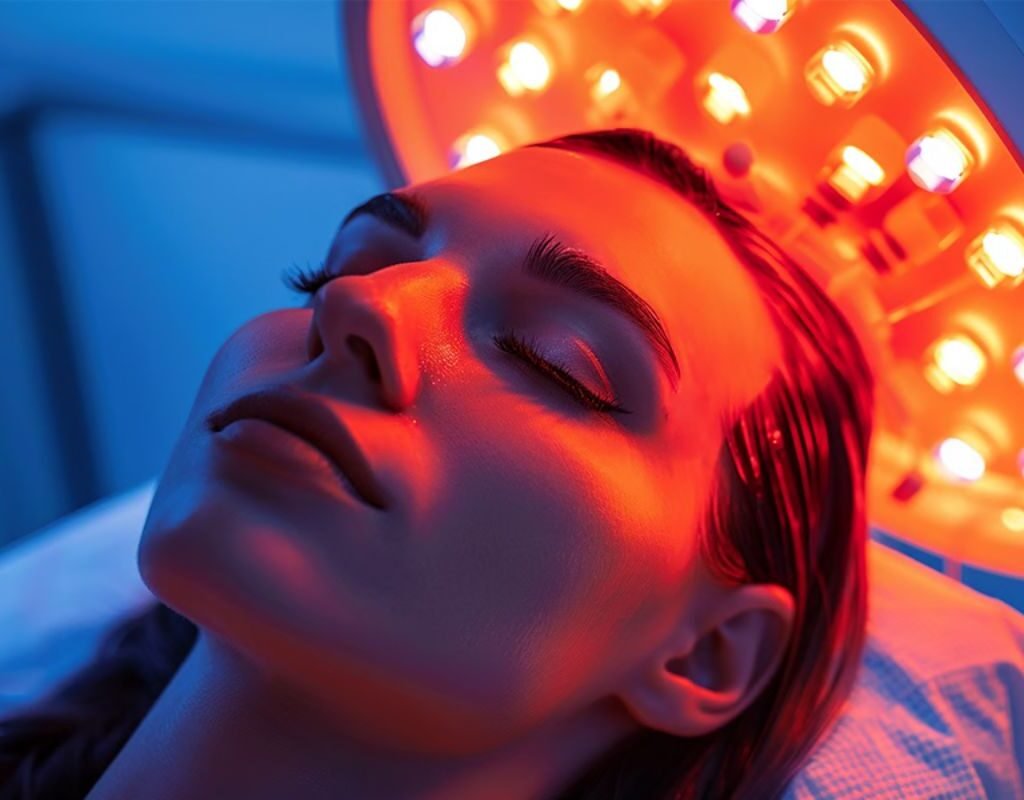Step aside, fairy tales; the real magic wand today is Blue Light Therapy!
Not only does it zap away stubborn pimples, but it also offers superhero powers for your mood and sleep. Forget frogs and slippers, now, all it takes is a targeted burst of Photodynamic Therapy (PDT) to wake up looking fresher and feeling brighter.
Ready to start this radiant journey? Roll up your sleeves and let’s illuminate the real benefits, side effects, and game-changing facts behind Blue Light Therapy. You might just glow with happiness (and health) after reading this.
What Is Blue Light Therapy?
Blue Light Therapy is a breakthrough treatment that uses specific blue wavelengths, usually between 400 and 500 nanometers, to gently target skin concerns and mood imbalances. It is also known as “Photodynamic Therapy (PDT)”. This non-invasive method works without heat or pain and is most famous for its use in dermatology. Its unique blue light triggers photochemical reactions in your skin, killing bacteria like P. acnes and supporting oil control and inflammation reduction.
In addition, Photodynamic Therapy (PDT) is gaining ground in mental wellness, thanks to its positive effect on circadian rhythms and seasonal mood dips. Photodynamic Therapy (PDT) is safe for most people and for all skin types when used as recommended, but always consult a dermatologist before starting new treatments.
How Blue Light Therapy Works?

Photodynamic Therapy (PDT) operates by sending blue light beams onto your skin or into your eyes, depending on the type of treatment. For skin issues, the blue light penetrates the epidermis and damages the bacteria membranes responsible for acne, shrinking oil production, and calming inflammation. In clinical use, Blue Light Therapy can include photosensitizing agents for deeper effects, especially in oncology.
For mood and sleep regulation, Photodynamic Therapy (PDT) works by influencing the brain’s circadian rhythms, helping regulate sleep-wake cycles, boost alertness, and balance hormone release. Most at-home devices require daily sessions, while professional clinics tailor intensity and application to your unique needs.
Benefits of Photodynamic Therapy (PDT)
Blue Light Therapy offers many skin and health benefits that make it a favorite for both doctors and skincare enthusiasts. It’s gentle, effective, and doesn’t need needles or surgery. Let’s look at its key advantages in detail.

1. Acne Reduction
One of the most common uses of Photodynamic Therapy (PDT) is for treating acne. The blue light targets Propionibacterium acnes bacteria, the tiny culprits behind most breakouts. When these bacteria are exposed to blue light, they die off naturally. The therapy also helps reduce excess oil in your skin, which keeps pores clean and prevents new pimples from forming. Regular sessions can make skin clearer, smoother, and less prone to inflammation.
2. Improved Skin Texture and Tone
If your skin looks dull, tired, or uneven from sun damage or early signs of aging, this therapy can help. The therapy supports natural healing by boosting circulation and cell turnover. Over time, it can fade sunspots, reduce fine lines, and make your skin look brighter and more even. Many people describe their skin as feeling “refreshed” and “glowing” after several treatments.
3. Treatment of Precancerous Skin Changes
Doctors also use Photodynamic Therapy (PDT) for treating actinic keratoses, rough, scaly patches that form after long-term sun exposure. These patches can sometimes turn into skin cancer if untreated. In this procedure, a special solution is first applied to the affected area, then activated by blue light. The light destroys abnormal cells while leaving healthy skin untouched. It’s a proven, non-surgical way to treat early skin changes caused by UV damage.
4. Anti-Inflammatory Effect
Inflammation is a root cause of many skin problems, from eczema to psoriasis. Blue Light Therapy helps reduce inflammation by calming overactive immune responses in the skin. It can ease redness, swelling, and itchiness. While research is still ongoing, early results show that blue light can help manage flare-ups when used under medical guidance. This makes it a gentle option for people with sensitive or easily irritated skin.
5. Non-Invasive and Minimal Downtime
One of the best parts about Photodynamic Therapy (PDT) is how easy it fits into daily life. There are no needles, cuts, or anesthesia involved. A typical session lasts 15 to 30 minutes, and you can return to work or school right afterward. Some mild redness or warmth is normal, but it fades quickly. Because the treatment is non-invasive, there’s little to no downtime, making it perfect for busy people who want visible results without disrupting their schedule.
6. At-Home Possibility
Thanks to technology, this therapy is no longer limited to clinics. You can now find FDA-approved at-home devices like LED masks and handheld wands. These gadgets use lower-intensity blue light, making them safe for regular use. They’re convenient for maintaining clear skin between professional visits or for tackling mild acne and oil buildup. However, results take longer, and it’s important to follow the device’s safety instructions carefully.
In short, Blue Light Therapy provides a safe and versatile way to care for your skin. It fights acne, improves tone, repairs sun damage, and calms inflammation, all without the need for harsh treatments. Whether you’re trying to manage breakouts or refresh your complexion, it’s a modern, science-backed solution that fits into everyday life.

How Green Light Therapy Transforms Pain, Sleep, and Skin for Her?
Green light therapy offers a gentle, non-drug option for women seeking relief from pain, skin issues, and sleep troubles. By fitting into a simple routine and understanding the science, you can make it a smart wellness tool.
Risks and Side Effects
These risks mean Photodynamic Therapy (PDT) is generally safe, but you should use it under guidance, especially for stronger treatments.
At-Home vs. Professional Treatments
When comparing professional clinic sessions and at-home devices for Blue Light Therapy, here’s how they stack up:
Professional Treatments

- Done in a dermatologist’s or skin clinic with high-power devices.
- May involve a photosensitiser agent (in PDT) plus controlled blue light exposure.
- More precise targeting, stronger results, supervised by trained staff.
- Higher cost, possibly more downtime, and need for post-treatment care (e.g., sun avoidance).
- Suitable for moderate to serious skin conditions, acne, and precancerous lesions.
At-Home Treatments

- Lower-intensity devices you can buy or rent (masks, wands) for Blue Light Therapy.
- Convenient, low downtime, and more affordable.
- Results are typically slower/milder compared to professional sessions.
- You must follow instructions carefully, protect your eyes, and avoid misuse.
- Best for maintenance, mild skin issues, or people who are already under medical supervision.
Which to choose?
- If you have serious skin issues (acne that resists treatment, precancerous skin spots), professional Blue Light Therapy is wise.
- If you have mild concerns and want regular upkeep, an at-home device can complement your routine.
- Always consult a dermatologist before starting, especially because devices vary in strength, safety certifications, and your skin type may require a customised plan.

Best Red Light Therapy for Hair Growth: A Guide to Top Choices and Benefits
Incorporating red light therapy into your hair care routine doesn’t have to be complicated. Follow this step-by-step guide for optimal results:
Facts and Stats Related to This Blog
- Blue light wavelengths used in therapy typically range from about 400 to 500 nm.
- One review found blue light treatment induced an anti-inflammatory effect in skin cells (i.e., reduction of IL-6 and TNF-α by dendritic cells).
- In a study treating 17 patients with plaque psoriasis using blue light, after 4 weeks, three times weekly, the results were mixed; some improved.
- According to the Cleveland Clinic, at-home LED light therapy devices (including blue light) are less powerful than professional ones; you may need many sessions to see a change.
- Research shows that blue light exposure at night suppresses melatonin twice as much as green light does in one experiment.
- These facts underline that Blue Light Therapy is rooted in scientific study but still requires responsible usage.
Frequently Asked Questions (FAQs)
Q1: How many sessions of Blue Light Therapy are needed?
It depends on the condition and device. Professional sessions often require weekly treatments for several weeks, followed by maintenance. At-home devices may ask for daily usage for several weeks.
Q2: Is Photodynamic Therapy (PDT) painful?
No major pain is typical. You might feel warmth or tingling, or see redness afterwards, but the treatment is generally non-invasive.
Q3: Can Blue Light Therapy help deep wrinkles or deep skin issues?
Blue light acts mostly on the surface of the skin, so deep wrinkles or deep tissue issues may not respond as well. Red or near-infrared lights often target deeper layers.
Q4: Are at-home Photodynamic Therapy (PDT) devices safe?
They can be safe if you follow instructions, wear protective eye gear if required, and ensure the device is FDA-cleared or medically reviewed. But intensity is lower compared to clinics.
Q5: Who should avoid this therapy?
People undergoing certain medications that increase light sensitivity (like isotretinoin), those with a history of skin cancers or inherited eye diseases, or pregnant people should consult a doctor first.
Conclusion
Remember that simple glowing intro where we set the scene? That’s exactly why Blue Light Therapy works: it’s a clean, targeted glow-reset for your skin and mood. Done right, it can fight stubborn breakouts, bring calm to flare-ups, and give you a fresh-faced edge without surgery or heavy downtime. Use it under proper guidance, match the method to your need (home vs. clinic), watch the aftercare, and you’ll be aligned with both science and glow. Your skin, your mood, and your light-powered reset are ready for action. Shine on.









